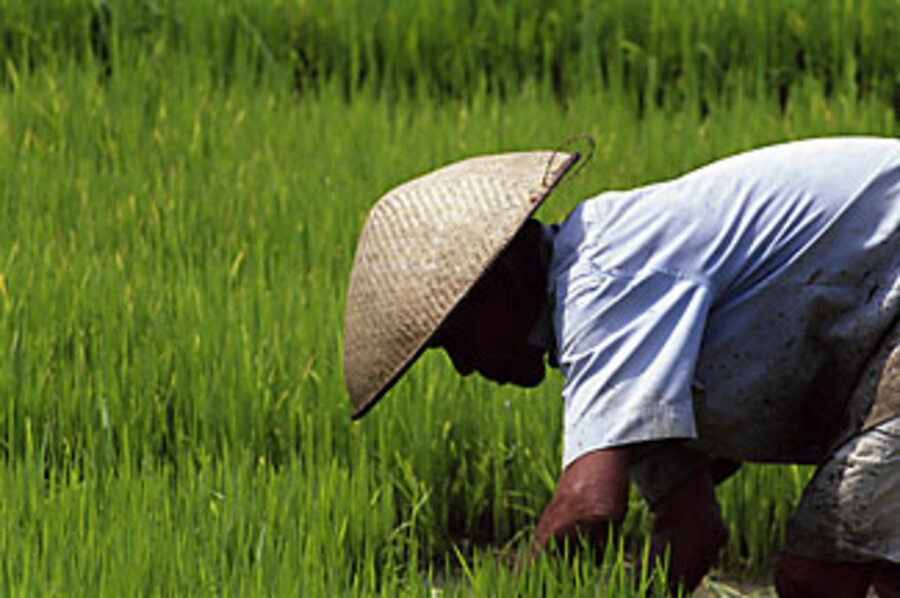Indonesia's answer to rising food prices
Loading...
| SUKABUMI, INDONESIA
With a milling plant and a hectare of rice paddy, Aan Suharlan is fully invested in Asia's favorite food staple. Rice put his two grown-up children through school and has given him status in his village. But when he sees other farmers plow over their rice fields, he knows why they're giving up on the grain.
"It's expensive to plant rice because of high production and labor costs. It's difficult to find laborers here – everyone wants to work in the factories," he says.
For months, the soaring price of food – especially rice – has been on everyone's lips after international prices nearly tripled between January and April. Prices have since eased off, but the shock waves continue to reverberate across Asia, where politicians are talking up food security and tariff protection.
In theory, higher global prices should mean more income for rice farmers here on Java, the breadbasket of this archipelago nation of 228 million who together eat around 32 million tons a year. Some of the benefits are trickling down to farmers, but they may not be enough to halt the steady shrinkage of rice paddy, which agriculturalists say is one factor driving up prices.
So Indonesia's government is offering incentives to plant more rice and improve other inputs to raise yields.
A new draft bill before Indonesia's parliament would strengthen existing land-usage laws on 15 million hectares of agricultural land. The government is also opening up large tracts of land on Papua and other eastern islands for rice and other food crops, trying to offset the shrinkage on Java. The disadvantage is much lower crop yields on these islands compared with those on Java's fertile soil, typically 24 percent less for rice, says Siwi Purwanto, director-general of food crops at the Ministry of Agriculture.
Still, these measures are vital to produce more rice, he says. "We have to protect rice production areas. Our population is growing and we are building more housing and highways. Areas with good irrigation systems are the target of developers," he says.
The government is also subsidizing fertilizer and hybrid seeds, as well as repairing irrigation channels to ensure water supplies.
For now, Indonesia's stocks are in good shape: The national logistics agency, which buys and sells rice to stabilize prices, plans to stockpile up to 3.8 million tons this year from a harvest estimated to reach 34 million tons. Last year, Indonesia imported 1.3 million tons, putting it among the world's top rice buyers.
Indonesia's drive for self-sufficiency in rice and other staples is a logical response to the global food crisis, says Neil McCulloch, director of economic programs at the Asia Foundation in Jakarta and an expert on the politics of rice.
But it may not be the right response if it leads rice-growing countries down a protectionist path that gums up global markets. Export restrictions by Vietnam and India sparked this year's price spikes and encouraged Indonesia and other producers to follow suit.
Moreover, pumping money into domestic agriculture in an industrializing country like Indonesia doesn't necessarily help the urban poor or lead to the most productive use of land by its owners, says Mr. McCulloch. "You have to pick what you want to tackle – poverty reduction or self-sufficiency? If farmers who plant rice decide that it's better to plant fruit or sell the land or build on it ... why tell them that it needs to be for rice production?"
In effect, economists are asking Indonesia and other countries to put their trust in global markets to deliver rice at reasonable prices when their own stocks run low. Some argue that producing countries should commit to exporting surplus crops so as to avoid a repeat of this year's spike. Such a pact would benefit Indonesia, which has only achieved self-sufficiency in rice in two of the past hundred years, according to McCulloch's research.
After the recent run-up in prices, governments may draw the opposite lesson, though: that only a solid agricultural base can deliver food security in uncertain times. "Political stability depends on the rice supply.... No rice means revolution," says Mr. Siwi.
This should mean a shift in budgets after decades of underinvestment in food crops, says Mahyuddin Syam, country director for the International Rice Research Institute based in Manila. "Now the government is willing to pay attention to rice. There is a commitment to rehabilitating irrigation channels, to provide funds for extension services and to open new land outside Java," he says.
Mr. Suharlan says his land, on a lush slope a two-hour drive south of Jakarta, isn't for sale. Like other farmers here, he's considered switching to cassava or papaya because they require less fertilizer and less labor. Most of the rice grown in the area is sold here, as other growing areas have larger surpluses to sell to city markets.
Farm-gate prices have climbed in recent months, though far less dramatically than those of international rice prices and local food items like eggs and meat. Analysts say rice prices may start to rise more sharply later in the year due to fuel-related inflation.
Poorer farmers who till small plots – Indonesia's average is 0.3 hectares – tend to hold onto their own crop, then buy rice when their stocks run out. Squatting on his front porch, Ocin, a subsistence farmer who goes by one name, says none of his seven children have followed him into the fields. "It's a dark future for rice here," he says.





